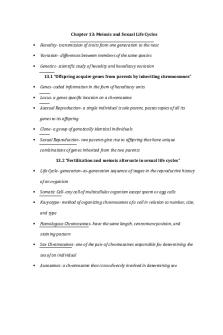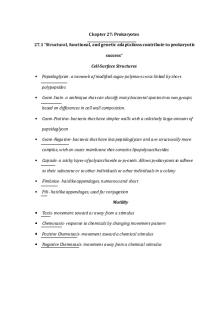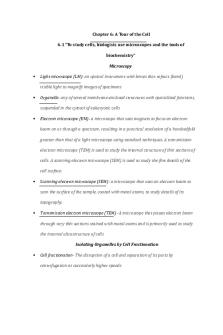Chapter 39 Vocab - Summary Campbell Biology PDF

| Title | Chapter 39 Vocab - Summary Campbell Biology |
|---|---|
| Course | Introduction to Biology A |
| Institution | University of Pennsylvania |
| Pages | 6 |
| File Size | 123.2 KB |
| File Type | |
| Total Downloads | 8 |
| Total Views | 138 |
Summary
Vocab definitions...
Description
Chapter 39: Plants Responses to Internal and External Signals 39.1 “Signal transduction pathways link signal reception to response”
Etiolation- morphological adaptations for growing in darkness
De-etiolation- when a shoot reaches the sunlight and undergoes profound changes such as slowing elongation of stem, leaves expanding, roots elongating, and the shoot producing chlorophyll Transduction
Second Messengers- small, internally produced chemicals that transfer and amplify the signal from the receptor to other proteins that cause the response 39.2 “Plant hormones help coordinate growth development, and responses to stimuli”
Hormones- chemicals signals that coordinate the different parts of an organism; a signaling molecule that is produced in tiny amounts by one part of an organism's body and transported to other parts, where it binds to a specific receptor and triggers responses in target cells and tissues The Discovery of Plant Hormones
Tropism- any growth response that results in plant organs curving away or toward from stimuli
Phototropism- the growth of a shoot toward or away from light (positive phototropism for toward and negative phototropism for away) A Survey of Plant Hormones Auxin
Auxin- a term used for any chemical substance that promotes elongation of coleoptiles; the natural auxin in plants is indoleactic acid (IAA)
Expansins- enzymes that break the cross-links (hydrogen bonds) between cellulose microfibrils and other cell wall constituents, loosening the wall’s fabric in response to the acidification of the wall Cytokinins
Cytokinins- growth regulators that stimulate cytokinesis; the most common is zeatin because it was first discovered in maize Gibberellins
Gibberellin- a chemical that has a variety of effects in plants such as stem elongation, fruit growth, and seed germination Brassinosteroids
Brassinosteroids- steroids that are chemically similar to cholesterol and sex hormones of animals. They induce cell elongation and division in stem segments and seedlings at concentrations as low as 10^-12 M; similar to auxins, but are different Abscisic Acid
Abscisic acid (ABA)- ABA slows growth, it often antagonizes the actions of growth hormones, and the ration of ABA to one or more growth hormones determines the final physiological outcome Ethylene
Ethylene - active factor in illuminating gas; produced by plants in response to stresses such as flooding, mechanical pressure, injury, and infection. Production
also occurs in fruit ripening and programmed cell deal and in response to high concentrations of externally applied auxin
Triple Response- enables the shoot to avoid the obstacle. Three parts of this response area slowing of stem elongation, a thickening of the stem (which makes it stronger), and a curvature that causes the stem to start growing horizontally
Aptosis- programmed cell death 39.3 “Responses to light are critical for plant success”
Photomorphogenesis - effects of light on plant morphology
Action Spectrum- depicts the relative effectiveness of different wavelengths of radiation in driving a particular process
Blue-Light Photoreceptors- absorb mostly red light; initiates phototropism, the light-induced opening of stomata, and the light-induced slowing of hypocotyl elongation that occurs when a seedling breaks ground
Phytochromes- absorb mostly red light; play a role in seed germination and shade avoidance Biological Clocks and Circadian Rhythms
Circadian Rhythms- cycles of a frequency of 24 hours not directly controlled by any known environmental variables Photoperiodism and Responses to Seasons
Photoperiodism- a physiological response to photoperiod, such as flowering Photoperiodism and Control of Flowering
Short-Day Plant- plants that require a light period shorter than a critical length to flower; usually flower in later summer, fall or winter
Long-Day Plants- plants that generally flower in late spring or early summer. E.g. Spinach
Day-Neutral Plants- unaffected by photoperiods, flower when they reach a certain stage of maturity, regardless of day length. Egg. Tomatoes, rice, and dandelions
Vernilization- pretreatment with cold to induce flowering A Flowering Hormone?
Florigen- the flowering signal, not yet chemically identified 39.4 “Plants respond to a wide variety of stimuli other than light” Gravity
Gravitropism- plants adjusting growth in response to gravity; roots display positive gravitropism and shoots exhibit negative gravitropism
Statoliths- specialized plastids containing starch grains to allow plants to detect gravity Mechanical Stimuli
Thigmomorphogenesis- changes in form that result from mechanical perturbation
Thigomotropism- the directional growth in response to touch
Action Potentials- impulses that resemble slow nerve impulses in animals Environmental Stresses
Abiotic- nonliving
Biotic- living Heat Stress
Heat-Shock Proteins- proteins which help protect other proteins from heat stress 39.5 “Plants defend themselves against herbivores and pathogens”
Defenses Against Herbivores
Jasmonic Acid- an important molecule in plant defense against herbivores Defenses Against Pathogens Gene-for-Gene Recognition
Virulent- pathogens against which a plant has little specific defense
Avirulent - strains of pathogens that are mildly harmful, but do not kill the host plant
Gene-for-gene Recognition - a widespread form of plant disease resistance that involves recognition of pathogen derived molecules by the protein products of specific plant disease resistance R genes Plant Responses to Pathogen Invasions
Elictors- molecules that induce a broad type of host defense response
Oligosaccharins- a type of elictor that is derived from cellulose fragments released by cell wall damage
Phytoalexins- An antibiotic, produced by plants, that destroys microorganisms or inhibits their growth
PR proteins- a protein involved in plant responses to pathogens (PR = pathogenesis-related)
Hypersensitive Response (HR) - A plant's localized defense response to a pathogen Systemic Acquired Resistance
Systemic Acquired Resistance (SAR) - a defensive response in infected plants that helps protect healthy tissue from pathogenic invasion
Salicylic Acid - a plant hormone that may be partially responsible for activating systemic acquired resistance to pathogens...
Similar Free PDFs

Ch26 - Summary Campbell Biology
- 6 Pages
Popular Institutions
- Tinajero National High School - Annex
- Politeknik Caltex Riau
- Yokohama City University
- SGT University
- University of Al-Qadisiyah
- Divine Word College of Vigan
- Techniek College Rotterdam
- Universidade de Santiago
- Universiti Teknologi MARA Cawangan Johor Kampus Pasir Gudang
- Poltekkes Kemenkes Yogyakarta
- Baguio City National High School
- Colegio san marcos
- preparatoria uno
- Centro de Bachillerato Tecnológico Industrial y de Servicios No. 107
- Dalian Maritime University
- Quang Trung Secondary School
- Colegio Tecnológico en Informática
- Corporación Regional de Educación Superior
- Grupo CEDVA
- Dar Al Uloom University
- Centro de Estudios Preuniversitarios de la Universidad Nacional de Ingeniería
- 上智大学
- Aakash International School, Nuna Majara
- San Felipe Neri Catholic School
- Kang Chiao International School - New Taipei City
- Misamis Occidental National High School
- Institución Educativa Escuela Normal Juan Ladrilleros
- Kolehiyo ng Pantukan
- Batanes State College
- Instituto Continental
- Sekolah Menengah Kejuruan Kesehatan Kaltara (Tarakan)
- Colegio de La Inmaculada Concepcion - Cebu














